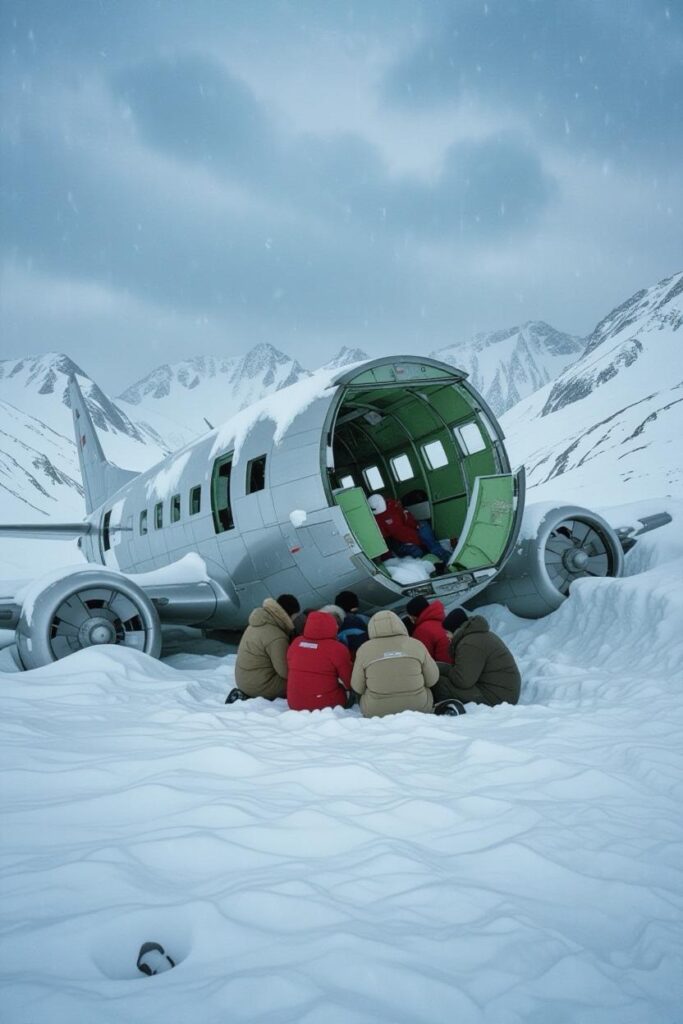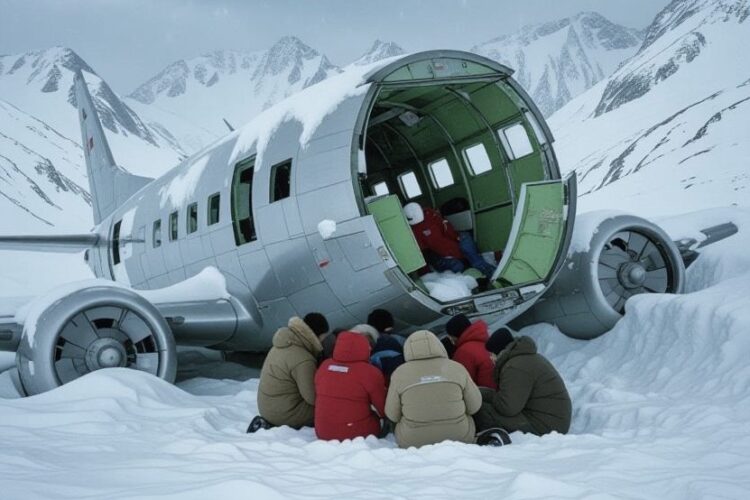On October 13, 1972, Uruguayan Air Force Flight 571 crashed in the Andes Mountains, carrying 45 people, including the Old Christians rugby team. The plane hit a peak, killing 12 instantly, leaving 33 survivors stranded in snow at 11,500 feet. With minimal food, they resorted to cannibalism after an avalanche killed eight more. After 72 days, Roberto Canessa and Nando Parrado trekked 38 miles to find help, leading to the rescue of 16 survivors on December 22. Their story of survival inspired books like Alive and Miracle in the Andes, and the 2023 film Society of the Snow. As of October 2025, 13 survivors remain, their ordeal a testament to human resilience.
Long Version
The Miracle in the Andes: Survivors of the 1972 Uruguayan Air Force Flight 571 Plane Crash
The 1972 crash of Uruguayan Air Force Flight 571 stands as one of history’s most harrowing tales of tragedy, disaster, and ultimate miracle, where a group of stranded individuals, including members of the Old Christians rugby team, endured 72 days in the unforgiving snow of the Andes Mountains, resorting to cannibalism for survival before their dramatic rescue.
The Fateful Flight and Devastating Crash
On October 13, 1972, Uruguayan Air Force Flight 571, a chartered Fairchild FH-227D turboprop, departed from Montevideo, Uruguay, en route to Santiago, Chile, carrying 45 people: five crew members and 40 passengers, primarily the Old Christians rugby team along with their supporters, family, and friends. The flight had stopped overnight in Mendoza, Argentina, due to adverse weather, before resuming the journey across the Andes Mountains. Pilot error led to a catastrophic miscalculation; believing they had cleared the range, the crew began descending too early, causing the plane to clip a mountain peak, lose both wings, and crash into a remote glacier in Argentina’s Valley of the Tears, near the Chilean border, at an elevation of about 11,500 feet. The impact killed 12 instantly, leaving 33 survivors amid the wreckage, where the fuselage became their makeshift shelter against relentless snow and freezing temperatures.
Immediate Aftermath and the Fight for Survival
Stranded in the high Andes Mountains, the survivors faced an immediate ordeal of subzero conditions, limited supplies, and severe injuries. Food rations—candy bars, wine, and snacks—lasted only a week, forcing desperate measures. The group’s rugby team background fostered a sense of camaraderie, but the disaster’s scale tested their limits. Search efforts, based on erroneous location data, failed to spot the white fuselage against the snow, and after eight days, officials called off the operation, assuming no one had survived the 1972 crash. Over the following weeks, six more perished from injuries and exposure, reducing their number to 27.
On October 29, a massive avalanche buried the fuselage, killing eight more and trapping the remaining 19 in a suffocating tomb of snow for three days. This event intensified their desperation, as they dug out using whatever tools they could improvise. With no rescue in sight, the survivors turned to the unthinkable: cannibalism. After ethical debates, they began to eat the dead, cutting flesh from frozen bodies preserved by the cold to sustain themselves—a decision that became central to their survival story.
The Expedition for Help and Path to Rescue
As weeks turned into months, the group organized expeditions to seek aid. Key figures emerged, including medical student Roberto Canessa, who led efforts to ration food and treat wounds, and Fernando “Nando” Parrado, who had lost his mother and sister in the crash and avalanche. On December 12, after 72 days stranded, Parrado, Canessa, and Antonio “Tintin” Vizintín set out on a perilous trek, equipped with makeshift gear from the wreckage. Vizintín returned after three days to conserve resources, leaving Parrado and Canessa to continue across treacherous terrain.
After 10 grueling days, covering nearly 38 miles, they descended into greener valleys and encountered Chilean herdsmen on December 20 near Los Maitenes. Communicating across a river via notes thrown with rocks—one reading, “I come from a plane that fell in the mountains”—they alerted authorities. Helicopters arrived on December 22, 1972, rescuing six survivors that day, with the remaining eight evacuated on December 23 amid worsening weather. In total, 16 survived the ordeal, their rescue marking the end of a 72-day saga of survival against unimaginable odds.
The Survivors and Their Enduring Legacy
The 16 survivors, mostly from the Old Christians rugby team, included Roberto Canessa, who became a renowned pediatric cardiologist and motivational speaker; Nando Parrado, an author and businessman; and others like Daniel Fernández Strauch, who played a vital role in organizing the group’s resources. They reunited annually on December 22 to commemorate their rescue. Over the years, some passed away: Javier Methol in 2015 from cancer, José Luis “Coche” Inciarte in 2023 from cancer, and Daniel Fernández Strauch on May 8, 2025, at age 79. As of October 2025, 13 remain alive, many sharing their experiences to inspire resilience and human spirit.
Cultural Impact and Media Adaptations
The story’s profound themes of survival and ethics have inspired numerous works. Piers Paul Read’s 1974 book Alive: The Story of the Andes Survivors detailed the events through interviews, later adapted into a 1993 film starring Ethan Hawke. Nando Parrado’s 2006 memoir, Miracle in the Andes, offered a personal perspective. Pablo Vierci’s 2008 book La sociedad de la nieve (Society of the Snow) focused on collective experiences, adapted into J.A. Bayona’s 2023 Netflix film Society of the Snow, which earned critical acclaim for its authentic portrayal. The incident also loosely inspired the TV series Yellowjackets, exploring similar themes of isolation and moral dilemmas in a fictional context.
This event remains a testament to human endurance, transforming a plane crash tragedy into a miracle of survival, where the Andes Mountains’ harsh snow became the backdrop for an unforgettable ordeal.

Hashtags For Social Media
#AndesPlaneCrash #1972AndesCrash #SocietyOfTheSnow #MiracleInTheAndes #SurvivalStory #TrueSurvival #AndesSurvivors #UruguayanFlight571 #OldChristiansRugby #NandoParrado #RobertoCanessa #72DaysStranded #CannibalismSurvival #AndesMiracle #AvalancheOrdeal #ExpeditionForHelp #FrozenBodies #RugbyTeamTragedy #ValleyOfTears #AliveTheStory #PiersPaulRead #JABayonaFilm #PabloVierci #YellowjacketsInspired #HumanResilience #InspirationalTale #HistoricalDisaster #NetflixSurvival #PlaneCrashSurvival #MountainsMiracle
Related Questions, Words, Phrases
what happened in the 1972 andes plane crash | survivors of uruguayan air force flight 571 | how did the andes crash survivors resort to cannibalism | true story of the miracle in the andes | who were the old christians rugby team in the 1972 crash | details on the 72 days stranded in the snow | nando parrado’s role in the andes survival | roberto canessa and the expedition for help | books about the andes plane crash survivors | alive: the story of the andes survivors summary | society of the snow movie explained | what caused the 1972 andes plane crash | avalanche impact on the stranded survivors | ethical debates on cannibalism in survival situations | how many survived the uruguayan flight 571 disaster | rescue date of the andes crash victims | valley of the tears location in the andes | frozen bodies and survival tactics in the crash | piers paul read’s book on the miracle | pablo vierci’s la sociedad de la nieve insights | yellowjackets tv series inspiration from andes story | recent deaths among andes survivors as of 2025 | annual reunions of the 1972 crash survivors | nando parrado’s memoir miracle in the andes | ja bayona’s film adaptation of society of the snow | pilot error in the fairchild fh-227d crash | makeshift shelter from the fuselage in the andes | trek distance covered by parrado and canessa | chilean herdsmen who helped the survivors | total passengers on flight 571 before the crash | how the survivors communicated for rescue | long-term legacy of the andes ordeal | specific injuries faced by the stranded group | cultural impact of the 1972 andes tragedy






